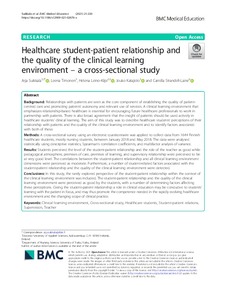Healthcare student-patient relationship and the quality of the clinical learning environment - a cross-sectional study
Suikkala Arja; Timonen Leena; Leino-Kilpi Helena; Katajisto Jouko; Strandell-Laine Camilla
Healthcare student-patient relationship and the quality of the clinical learning environment - a cross-sectional study
Suikkala Arja
Timonen Leena
Leino-Kilpi Helena
Katajisto Jouko
Strandell-Laine Camilla
BMC
Julkaisun pysyvä osoite on:
https://urn.fi/URN:NBN:fi-fe2021093048657
https://urn.fi/URN:NBN:fi-fe2021093048657
Tiivistelmä
Background
Relationships with patients are seen as the core component of establishing the quality of patient-centred care and promoting patients' autonomy and relevant use of services. A clinical learning environment that emphasizes relationship-based healthcare is essential for encouraging future healthcare professionals to work in partnership with patients. There is also broad agreement that the insight of patients should be used actively in healthcare students' clinical learning. The aim of this study was to describe healthcare students' perceptions of their relationship with patients and the quality of the clinical learning environment and to identify factors associated with both of these.
Methods
A cross-sectional survey using an electronic questionnaire was applied to collect data from 1644 Finnish healthcare students, mostly nursing students, between January 2018 and May 2018. The data were analysed statistically using descriptive statistics, Spearman's correlation coefficients, and multifactor analysis of variance.
Results
Students perceived the level of the student-patient relationship and the role of the teacher as good while pedagogical atmosphere, premises of care, premises of learning, and supervisory relationship were perceived to be at very good level. The correlations between the student-patient relationship and all clinical learning environment dimensions were perceived as moderate. Furthermore, a number of student-related factors associated with the student-patient relationship and the quality of the clinical learning environment were detected.
Conclusions
In this study, the rarely explored perspective of the student-patient relationship within the context of the clinical learning environment was included. The student-patient relationship and the quality of the clinical learning environment were perceived as good by the students, with a number of determining factors affecting these perceptions. Giving the student-patient relationship a role in clinical education may be conducive to students' learning with the patient in focus, and may thus promote the competence needed in the rapidly evolving healthcare environment and the changing scope of clinical practice.
Kokoelmat
- Rinnakkaistallenteet [27094]
